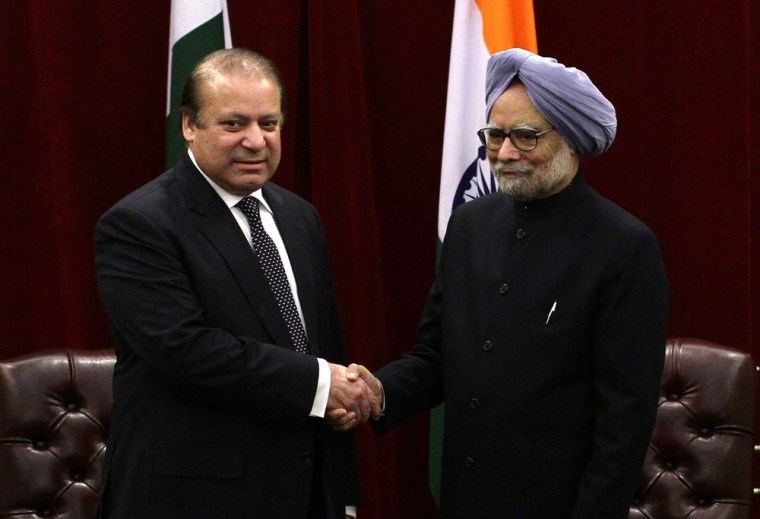ISLAMABAD – While the highly anticipated meeting between President Barack Obama and Iranian President Hassan Rouhani never shook out, there was another, lower profile, but still significant meeting on the sidelines of the United Nations General Assembly.
Indian Prime Minister Manmohan Singh and his Pakistani counterpart, Premier Nawaz Sharif, met for about an hour at New York’s Plaza Hotel on Sunday. Shaking hands for the cameras, the meeting signaled a new effort toward cooperation between the two nuclear-armed neighbors.
India and Pakistan have fought three wars over the disputed region of Kashmir. Tensions are currently high after a series of fatal cross-border clashes along the de facto Himalayan border led to the death of at least eight soldiers on both sides - plunging diplomatic relations to their lowest point in years.
The stakes are high. Both countries have nuclear weapons and their large military formations train while keeping the other side in their gunsights.
Pakistan is a key player in facilitating the Afghan reconciliation process as U.S. troops begin to withdraw from Afghanistan. Billions of dollars of military hardware is expected to be trucked down from Afghanistan through Pakistan’s roads and ports as the 2014 transition begins, while Islamabad continues to battle its own homegrown Taliban insurgency.
Meanwhile, India, the world’s largest democracy, is also a crucial economic and political ally of the U.S. and a major part of Washington’s “eye on China” policy for the Asia Pacific region.
What happened in the meeting?
The two sides agreed to restore the 2003 cross-border ceasefire which has been holding the peace in disputed Kashmir, one of the most militarized – and nuclearized – borders in the world.
India emerged from the meeting of more than an hour calling the talks "useful," while Pakistan called the atmosphere "very positive."
What’s the background?
Both prime ministers were coming with very different baggage into the talks. Singh, 81, who’s a two-time premier, is now in the lame-duck phase of his administration. He has often been criticized by the opposition as soft on Pakistan. But he talked tough at the U.N., calling Pakistan the “epicenter of terrorism” and categorically calling Kashmir a non-negotiable, integral part of India.
Sharif, on the other hand, is in his third stint in office, trying to consolidate civilian control in a country that has been ruled by the powerful military for three of the six decades since independence. (He’s been booted out of office before by the military). He has been criticized at home for promoting trade with India while not pushing the envelope on what the Islamabad establishment considers the “core issue” of Kashmir with New Delhi. Compared to Singh, his approach at the U.N. was softer, calling for “a new beginning” with India.
Why is this significant?
There are serious gains to be made if India and Pakistan can move towards peace. Pakistan has the fastest growing nuclear arsenal in the world; India is sinking billions into modern conventional weapons platforms as one of the planets biggest arms importers. Peace dividends would reduce defense budgets and help almost over 500 million Indians and Pakistanis climb above the poverty and illiteracy lines.
Also, if there is peace between the two dominant powerhouses of the region, there will be increased chances of a lasting settlement in Afghanistan after 2014.
That's why trade and energy routes, which are the obsessions of both prime ministers, could provide the linkages that soften borders across South Asia, potentially creating an interdependent Afghanistan-Pakistan-India that grows the region.
Related
